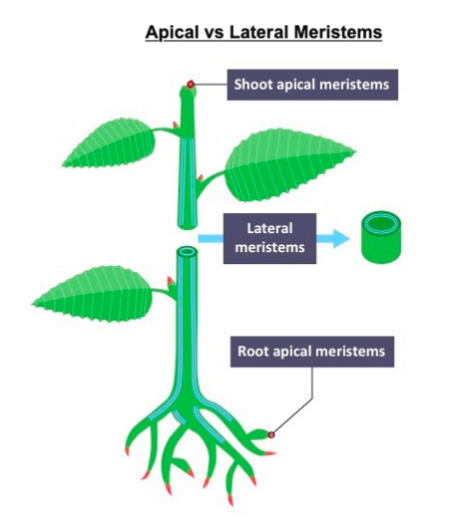IB Biology - Chapter 9.3: Growth in Plants
0.0(0)
Card Sorting
1/21
Earn XP
Description and Tags
Study Analytics
Name | Mastery | Learn | Test | Matching | Spaced |
|---|
No study sessions yet.
22 Terms
1
New cards
what are meristems?
they are tissues in a plant consisting of undifferentiated cells capable of growth, similar to totipotent cells in humans
2
New cards
what can meristematic tissue do?it
it can allow plants to regrow structures or form entirely new plants, and help in cell elongation
3
New cards
what are the two categories of meristematic tissue?
apical and lateral meristems
4
New cards
what are apical meristems and what do they do?
they occur at the shoot and root tips of a plant and are responsible for primary growth, also known as lengthening and leaf development

5
New cards
what are lateral meristems and what do they do?
they occur at the cambium and are responsible for secondary growth (plant widening or thickening, such as formation of bark)h
6
New cards
how does growth at the tips of roots and shoots happen?
it is a combination of cell enlargement and repeated cell division (mitosis). growth occurs in sections called nodes, with remaining meristem tissue forming an inactive axillary bud
7
New cards
what is an important plant hormone in plant growth?
the auxins
8
New cards
how do plant hormones control plant growth?
when auxins are produced by the shoot apical meristem, it promotes growth in the shoot apex by cell elongation and division. it also prevents the growth of lateral axillary buds
9
New cards
what is apical dominance?
it is when auxin promotes growth at the shoot apex and inhibits/prevents growth of the lateral axillary buds to ensure that the plant will use its energy to grow upwards towards the light
10
New cards
what are auxin efflux pumps and what can they do?
they can set up concentration gradients within tissues, changing the distribution of auxin within a plant. the pumps control the direction of plant growth by determining which regions of the plant tissue have high auxin levels and can change position within the membrane and are activated by various factors.
11
New cards
what is auxin’s mechanism in the shoots?
it stimulates cell elongation and thus a high concentration of auxin promotes growth, and also increases flexibility of the cell wall to promote growth
12
New cards
what is auxin’s mechanism in the roots?
it inhibits cell elongation and thus a high concentration of auxin limits growth
13
New cards
how does auxin increase the flexibility of the cell wall?
auxin activates a proton pump in the plasma membrane which causes the secretion of H+ into the cell wall. the resultant decrease in pH causes cellulose fibres to loosen. auxin also unregulated the expression of expansions, which increases the elasticity of the cell wall.
14
New cards
what are tropisms?
growth or turning movement of a plant in response to external stimulus
15
New cards
what is phototropism?
growth movement in response to undirectional light source
16
New cards
what is geotropism?
movement in response to gravitational forces
17
New cards
what is hydrotropism?
responding to a water gradient
18
New cards
what is thigmotropism?
response to a tactile stimulus
19
New cards
how does auxin distribution control phototropism in cells?
light receptors trigger redistribution of auxin to the dark side of the plant. in shoots, high auxin concentrations promote cell elongation, which means the dark side of the shoot elongates and shoot grows towards the light (positive phototropism). in the roots, high auxin leads to inhibition of cell growth, which means the dark side of the root becomes shorter and roots grow away from the light (negative phototropism)
20
New cards
how does auxin distribution control geotropism in cells?
auxin will accumulate on the lower side of the plant in response to the force of gravity. in shoots, higher auxin promotes cell growth, which means the lower side of the shoot elongates and roots grow away from the ground. in roots, high auxin inhibits cell elongation, which means the lower side of the root becomes shorter and turn downwards into the earth.
21
New cards
what is micropropagation?
it is a technique used to produce large numbers of identical plants from a selected stock plant
22
New cards
what are the steps of micropropagation?
1. specific plant tissue is selected from stock plant and sterilized
2. tissue sample (explant) is grown on sterile nutrient agar gel
3. explant is treated with growth hormones to stimulate shoot and root growth
4. growing shoots can be continuously divided and separated to form new samples (multiplication phase)
5. once root and shoot are developed, cloned plant can be transferred to soil